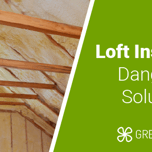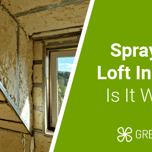Answer these simple questions and we will find you the BEST prices
Which type of solar quotes do you need?
It only takes 30 seconds
100% free with no obligation

Get Free quotes from insulation specialists near you

Save money by comparing quotes and choosing the most competitive offer

The service is 100% free and with no obligation
- GreenMatch
- Insulation
- Loft Insulation
Loft Insulation: The Ultimate Guide, Benefits and Tips for 2025

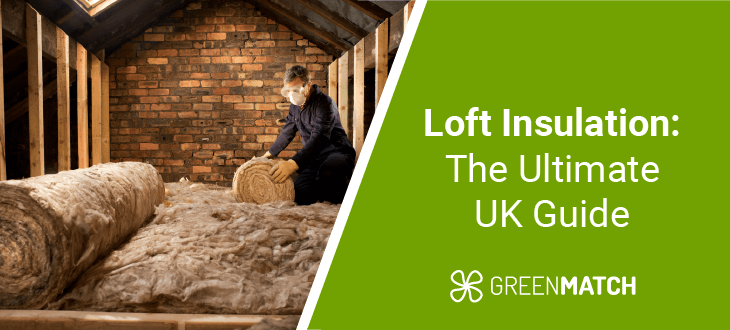
- On average, loft insulation in 2025 costs around £930 for a 3-bedroom semi-detached house in the UK.
- Proper loft insulation can reduce your annual energy bills by up to £270.
- Roof and loft insulation boasts a short payback period of around 3 years.
Uninsulated lofts and roofs are directly responsible for over 25% of the heat loss in a home, and yet a study by Resolution Foundation (RF) has shown that 1 in 5 homes in the UK have no form of roof or loft insulation at all. This in turn leads to drafty homes and soaring energy bills.
So how much difference does loft insulation make? Loft insulation is arguably one of the most useful and cost-effective insulation upgrades you can implement in your home. Effective insulation can bring about up to £270 in energy bill savings and up to 0.6 tonnes in carbon footprint reductions every year.
If you're asking yourself; how much does loft insulation cost? Then you've come to the right place. This ultimate guide will walk you through all you need to know about loft and roof insulation, including the process, insulation materials, costs, savings, and grants.
Eager to insulate your loft? Let GreenMatch UK take care of the hard work for you! By filling out our simple 30-second survey, you can receive up to 3 free quotes tailored to your home from our network of trusted professional installers in your area. Save yourself the hassle of endless hours of research and vetting, and maximise your chances at landing a bargain. Click below to begin!
- Describe your needs
- Get free quotes
- Choose the best offer
It only takes 30 seconds



What is loft insulation?
Loft insulation is when a barrier of insulating material is installed in your loft to minimise heat loss and temperature change in your home. This works by trapping heat in air pockets to prevent it from escaping, keeping your home warm during winter and cool during summer.
Most lofts in the UK already have some degree of insulation, but up to 20% of UK homes still lack appropriate measures. Current UK loft insulation regulations recommend at least 270mm of depth for loft insulation material, but the good news is that homes with existing insulation will spend much less on topping up their insulation rather than starting from scratch.
In any case, loft insulation is a highly worthy and cost-effective investment with a staggering lifespan of up to 40 years, making sure your home is warm for decades to come.
Another avenue of insulation for loft spaces is acoustic loft insulation. This differs from thermal loft insulation as it focuses on reducing sound transfer rather than heat transfer. Acoustic loft insulation materials have their own properties and price ranges to consider.
Benefits of insulating your loft
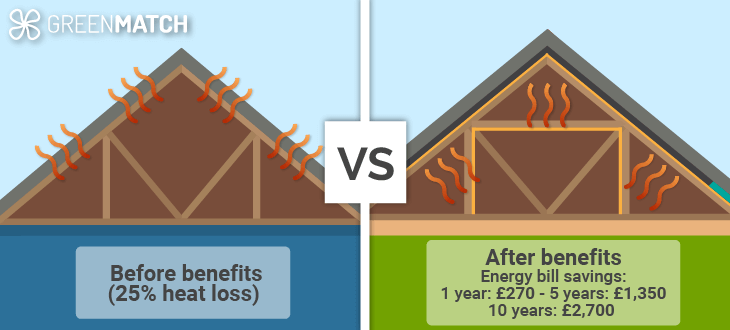
Up to a quarter of the heat produced in your home is prone to escape through poorly insulated lofts and roofs. This is reflected in drastically high energy bills as your heating system constantly overworks to compensate for heat loss. Not to mention, homes in the UK are the single largest contributor to carbon emissions from the entire built environment.
Quality loft conversion insulation brings about a wealth of benefits for your home, your wallet, and the environment. Here are just a few to consider:
- Higher savings: Loft insulation brings about an impressive £270 in annual energy bill savings for a standard 3-bedroom semi-detached home, also meaning a shorter payback period on your investment of just 3 years.
- Lower carbon emissions: Heat loss from lofts and roofs plays a huge role in domestic carbon dioxide emissions. Properly insulating your loft or roof can reduce your carbon footprint by an astonishing 0.6 tonnes every year.
- Better property value: Homes with proper insulation are valued much higher on the housing market due to better Energy Performance Certificate (EPC) ratings.
How much can you save by insulating your loft?
On average, insulating your loft can save you around up to £270 on energy bill savings every year in a 3-bedroom semi-detached house. These savings can vary depending on the type of property you have.
Normally speaking, lofts that lack insulation will need to get at least up to 270mm of insulating material installed as per government recommendations. Some homes may already have up to 120mm of insulation in place (usually in the form of insulation boards). Bringing this up to 270mm will cost far less, but still increase your annual savings.
Here is a full breakdown of expected savings per property type in England, Scotland, and Wales, based on the type of home you may have:
| Type of home | Annual savings (0mm - 270mm insulation) | Annual savings (120mm - 270mm insulation) |
|---|---|---|
| Detached house | £445 | £40 |
| Semi-detached house | £270 | £25 |
| Mid terrace house | £240 | £25 |
| Detached bungalow | £440 | £40 |
Keep in mind that savings may slightly differ if you are based in Northern Ireland, so here is what you could expect:
| Type of home | Annual savings (0mm - 270mm insulation) | Annual savings (120mm - 270mm insulation) |
|---|---|---|
| Detached house | £475 | £45 |
| Semi-detached house | £285 | £25 |
| Mid terrace house | £255 | £25 |
| Detached bungalow | £465 | £45 |
How much does it cost to insulate your loft?
The main question on every household's mind is often; how much is loft insulation? The cost of loft insulation for a standard 3-bedroom semi-detached property in the UK is around £930. A loft insulation cost depends on several factors, such as your loft size, insulation material, loft accessibility, and whether you hire a professional or do the job yourself. Replacing loft insulation can cause more than a standard new job, due to the labour work involved in removing old insulation material.
Below is a breakdown of the average costs you could expect per UK property type in England, Scotland, and Wales, along with the expected insulation costs per thickness:
| Type of home | Insulation costs (0mm - 270mm) | Insulation costs (120mm - 270mm) |
|---|---|---|
| Detached house | £1,200 | £930 |
| Semi-detached house | £930 | £760 |
| Mid terrace house | £880 | £720 |
| Detached bungalow | £1,200 | £940 |
Costs may differ a little bit for Northern Ireland, here is what you could expect:
| Type of home | Insulation costs (0mm - 270mm) | Insulation costs (120mm - 270mm) |
|---|---|---|
| Detached house | £1,300 | £1,100 |
| Semi-detached house | £840 | £800 |
| Mid terrace house | £740 | £760 |
| Detached bungalow | £1,700 | £1,600 |
Generally speaking, insulating detached UK homes and bungalows will cost the most, but in return will bring about the largest annual savings of around £440 - £445. Homes with existing insulation will benefit from increased savings by topping up to the government-recommended 270mm of insulation thickness.
An additional cost to consider is that of a professional installer. Finding the right installer can be more difficult than expected, requiring many hours of research and vetting online and through phone calls. With GreenMatch UK, you can free yourself from this burden and let us deliver the best bargains to you!
Simply fill out our easy 30-second form and receive up to 3 free quotes from our network of trusted local installers, tailored to your home with no extra fees or obligations. Click below to begin!
- Describe your needs
- Get free quotes
- Choose the best offer
It only takes 30 seconds



Insulation grants
Grants for loft insulation in the UK exist to help low-income and fuel-poor households in upgrading their energy efficiency. There are several active government schemes right now that provide partial coverage or free loft insulation upgrades based on your needs and qualifications:
- The Great British Insulation Scheme: Active until March 2026, this government-backed scheme assists qualifying households with one-off insulation measures, including a loft insulation grant. This allows the scheme to maximise its reach across the UK. You can directly apply for the scheme through the UK government portal.
- ECO4: Also active until March 2026, the ECO4 scheme differs as it puts direct responsibility on energy providers themselves to assist low-income and fuel-poor households with a variety of upgrades, including insulation. You cannot apply for the ECO4 scheme directly but can get in touch with your energy provider to see if you qualify to benefit.
If you or someone in your household already receives certain government benefits, or if you fall into a low personal income category, then you’ll likely qualify to receive a grant for loft insulation. Homes with low Energy Performance Certificate (EPC) bands also qualify for assistance through both schemes.
By comprehensively checking who is eligible for a loft insulation grant on the UK government's official portal, you can get a better picture of whether you qualify or not.
What you need to consider before the loft insulation
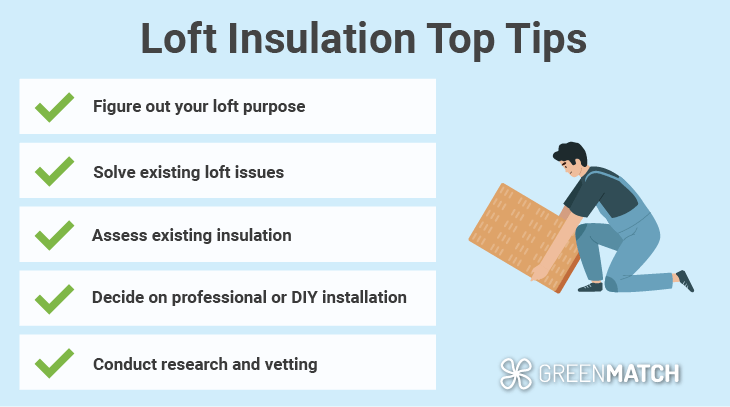
Your loft could be insulated in several ways and for several different purposes. There are a few things to consider before going ahead with loft insulation. Here’s a checklist of loft insulation dos and dont’s to keep in mind:
- Identify your loft's purpose.
Will your loft be used as storage or living space? This decision has a big role in determining the type of insulation you will need moving forward. This also determines the insulation r value of the material that best suits your insulation project.
- Identify any existing insulation.
If your loft has been previously insulated, chances are you can get away with minimal costs by just topping up with extra insulation material. Get your existing insulation properly checked for effectiveness by an assessor to determine whether it needs replacing or not.
If you are starting from scratch, choosing materials with low U-values and high R-values will ensure the best thermal efficiency. What is U-value in insulation? It tells us the rate of heat transfer through a material surface.
- Get your loft assessed.
Issues of draught and dampness in your loft can worsen with insulation. Make sure that existing issues are addressed and solved with a professional beforehand. Any vents, grills, or air bricks also need to remain unobstructed after insulating to make sure there is good air circulation.
- Hire a professional installer.
While DIY insulation installation can cost two or three times less than a professional installation, it’s important to know that a faulty job can cause a far greater headache through poor workmanship and mounting repair costs. Professional loft insulation installers will have the job completed in a fraction of the time, and up to high standards to make sure your loft stays insulated for decades to come.
Choosing the right loft insulation for your property
There are a few different types of loft insulation, and choosing the best type of insulation for homes depends on several factors such as your roof type, budget, existing insulation, and personal preferences. These factors will also influence your overall costs. If your attic is easy to access and you have regular joists and rafters, then insulating should be straightforward, and can even be done as a DIY loft insulation project.
For most lofts, there are two forms of insulation you can consider:
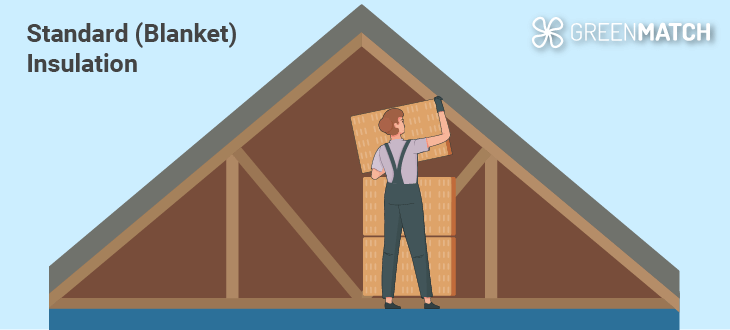
Standard (blanket) insulation: If your loft is safe and easy to access, then blanket insulation is the best choice for you. This is when sheets or batts of insulation are laid in between and over the floor joists, or roof rafters. Normally, mineral wool (glass or rock), fibreglass, or sheep wool is used for this job.
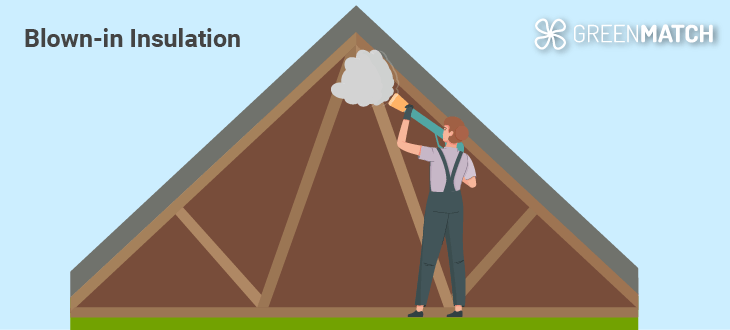
Blown-in insulation: For unsafe and hard-to-access lofts, go for blown-in insulation. This is when professional installers use special applicator hoses to spray insulation fibres into your loft area. It allows it to cover the whole surface area, including difficult crevices. Normally, cellulose, shredded fibreglass, or mineral wool variants are used. To learn more, check out our special guide on blow in insulation UK.
Having looked at these key factors and approaches to loft insulation, let’s now take a look at the different types of loft insulation materials available on the market, and for what specific purposes they are used.
What are the different types of loft insulation?
There are many different types of loft insulation, each suited for different purposes. The best loft insulation will depend on your roof type, budget, and personal needs. Here is a full breakdown of the most popular loft insulation materials, and their associated pros and cons:
Batt or blanket insulation: This is the most common type of loft insulation material. Often made from batts or rolls of mineral wool, reflective foil, fibreglass, or sheep's wool, these are laid in between floor joists and roof rafters before being covered up by floorboards or plasterboard.
- Wool loft insulation is straightforward to install, including DIY.
- Very versatile and can be cut into desired lengths.
- A great recycled alternative to synthetic insulation.
- Some materials can cause skin irritation and must be handled with protective gear.
- Not as helpful when insulating odd shapes, crevices, and hard-to-reach areas.
- Blanket insulation loses its insulation effectiveness if it’s compressed.
Loose-fill insulation: A cheap loft insulation that is lightweight and granular, typically made from cellulose, mineral wool, or cork. It is blown into loft spaces and can be added to top up any existing insulation.
- Very useful when insulating odd shapes, crevices, and hard-to-reach areas.
- A great ‘top-up’ solution if you already have existing insulation in place.
- A much cheaper and environmentally friendly alternative to spray foam.
- Loose-fill insulation can come loose in draughty lofts.
- Safety equipment is needed during installation to avoid inhaling or skin irritation.
- Although cheaper, loose-fill insulation is not as effective as spray foam loft insulation.
Rigid board (sheet) insulation: These are loft insulation boards used to insulate the sloping sides of roofs. It is made from several materials such as Polyisocyanurate (PIR) boards or expanded (EPS) and extruded (XEPS) Polystyrene. Greener alternatives include cork, straw, and wooden boards.
- A very effective insulator with highly effective thermal properties.
- Tend to be very robust, some variations are even flame and melt-resistant.
- Can be cut and sized easily, making it ideal for DIY installations.
- Synthetic insulation sheets are not environmentally friendly and use a lot of energy in their production.
- They tend to cost far more than other insulation materials.
Blown fibre insulation: A lightweight fibrous insulation that is blown into lofts by a professional installer using specialist applicator equipment. It is usually made from cellulose, fibreglass, or mineral wool.
- Very quick and straightforward installation when done with a professional.
- A versatile option that is great for insulating crevices and hard-to-reach areas.
- Lightweight and easy to handle.
- Requires a professional installer and industry-specific applicator equipment.
- Can be more expensive than other insulation materials.
- Not recommended for lofts with a draught problem.
You can also install spray foam insulation in a loft, but this is often not recommended as spray foam is incredibly difficult, complex, and expensive to remove, often surpassing the cost of installation.
How thick should the loft insulation be?
If you're wondering how thick should loft insulation be, the UK government suggests an optimum depth of at least 270mm as per regulations set since 2003. It is considered that up to 300mm loft insulation at most is the best in retaining heat. In any case, properties before and after 2003 can benefit from an assessment to make sure your existing insulation is up to standards.
Some homes may have up to 150mm loft insulation in place that falls below government recommendations. In this case, consider topping up your existing insulation at a cheaper cost, assuming that your insulation is properly installed, in good shape, and still effective.
How to insulate a loft
Insulating your loft is a great energy efficiency upgrade that can bring your home up to £270 in annual energy bill savings, with a short payback period of just 3 years. There are a few factors to consider before going ahead with a loft insulation project.
Perhaps the most important point you will need to decide is whether your loft will be used for storage or living purposes. This decision will greatly influence whether you need cold loft insulation or warm loft insulation.
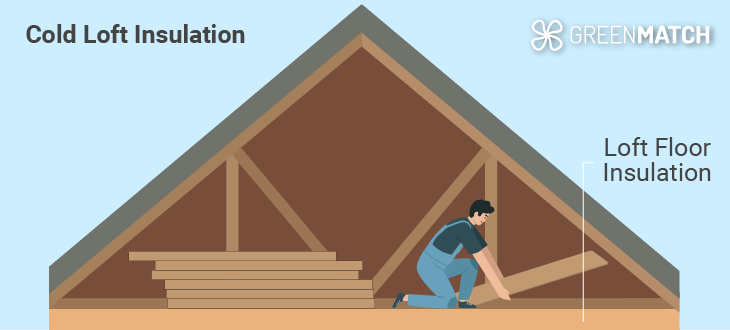
Cold loft insulation is the best loft insulation for storage purposes. This is when the loft floor is insulated to keep the rest of your house warm. Lift the floorboards, add 270mm of mineral wool in between the joists, and leave a 50mm air gap for ventilation. If you don’t have enough floor width, purchase loft legs from a hardware store to elevate the floor. While this can be done DIY, it is best to work with a professional to ensure the job meets regulations.
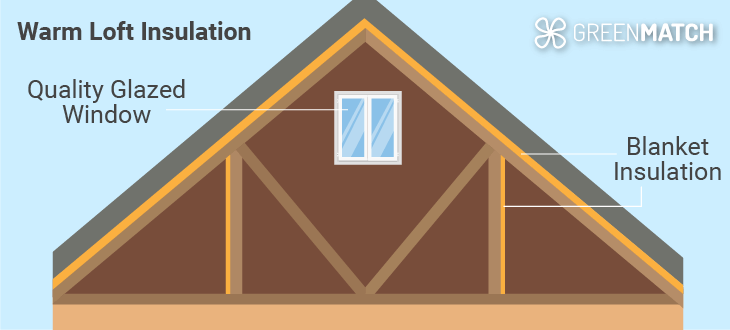
Warm loft insulation is best suited for a loft living space. This is when loft insulation between rafters is laid from the inside of the loft space, secured in place, and covered up with plasterboard. Roof rafters can also be insulated with spray loft insulation, although these tend to be expensive. The inner walls of the living area will also need to be insulated from the rest of the loft to ensure there is no heat loss. Windows or skylights also need quality glazing and draught proofing for quality insulation. This job is far more complex and requires professional loft insulation installers to carry out the job.
Choosing the right professional installer is no easy task itself. With all the options on the market, you can easily find yourself stuck in countless hours of phone calls and web pages for research and vetting. Here at GreenMatch UK, we want to free you from this burden by connecting you with our local network of professional installers so that you can land the best bargain for your home!
Simply fill out our quick 30-second form, and receive up to 3 free home-tailored quotes from installers right in your area. The best part? No extra charges or obligations apply. Click below to begin!
- Describe your needs
- Get free quotes
- Choose the best offer
It only takes 30 seconds



FAQ
The most popular insulation for a loft is standard (blanket) insulation. This is when sheets are laid under and in between the floor joists or roof rafters and secured in place. Blanket insulation is usually made from mineral wool (rock or glass), sheep’s wool, foil-backed felt, or fibreglass.
You don’t necessarily need to remove old loft insulation if it is dry, healthy, and not squashed. Loft insulation has a long lifespan of up to 40 years, so you might get by with topping up your existing insulation to the recommended 270mm. This will also be cheaper than starting from scratch. Consult with a professional assessor to determine your existing insulation health.
If your loft is easy to access and structurally secure, you can insulate your loft by yourself given you have done your research, and have the necessary protective gear. DIY loft insulation can save up to 70% of the costs associated with professional installation, but comes at a big risk of faulty insulation, health risks, and mounting repair costs in the future.
Since 2003, the UK government has recommended at least 270mm loft insulation material for optimum effectiveness. Houses with existing insulation that fall short of this thickness can easily top up for a smaller cost.
In general, 100mm loft insulation is not sufficient to achieve the best insulating capacity for your home. It is recommended to top up this amount to the government-recommended amount of at least 270mm. For homes with existing 200mm loft insulation that is dry and undamaged, topping up will be a very small cost.
Loft insulation costs for a 3-bedroom semi-detached home in the UK are around £930 for full loft insulation. Homes with existing insulation that need to top up will pay significantly less.
The cheapest loft insulation is called cold loft insulation. This is when sheets of blanket insulation (like mineral wool) are laid over and between the joists of your loft floor before adding back the floorboards. Your home will stay warm, but the inside of your loft will be uninsulated and unsuitable as a living space. This is normally done for lofts to be used as storage.

Akif is a copywriter at GreenMatch since 2023. With a keen interest in community sustainability, green solutions and the role of digital media in identifying climate trends, he aims to hone in on his background in International Studies and Digital Media to provide a multidisciplinary approach to written content rooted in credible research and accuracy.
We strive to connect our customers with the right product and supplier. Would you like to be part of GreenMatch?

- Loft Insulation: The Ultimate Guide, Benefits and Tips for 2025
- What is loft insulation?
- How much does it cost to insulate your loft?
- What you need to consider before the loft insulation
- Choosing the right loft insulation for your property
- What are the different types of loft insulation?
- How thick should the loft insulation be?
- How to insulate a loft
- FAQ

